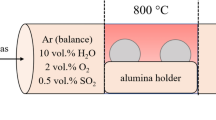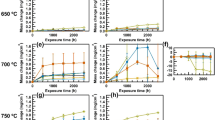Abstract
Pure Ni and Ni-xCr (x = 7, 14, 22 and 27 wt%) binary alloys were exposed to supercritical-carbon dioxide environment at 600 °C and 20 MPa for 200 h. For pure Ni, a thick NiO layer was formed on the surface. Meanwhile, for Ni-7Cr alloy, an inner oxide layer consisted of rather irregular chromia and NiO was formed below the outer NiO layer. When Cr content was greater than 14%, a continuous chromia layer was formed, resulting in much lower weight gain and oxide thickness. However, amorphous carbon layers had developed along the oxide–matrix interface when chromia was formed. The presence of the carbon layer was explained in view of the high C activity corresponding to the low equilibrium oxygen potential of chromia.









Similar content being viewed by others
References
E. J. Parma, S. A. Wright, M. E. Vernon, D. D. Fleming, G. E. Rochau, A. J. Suo-Anttila, A. A. Rashdan, P. V. Tsvetkov, Supercritical CO 2 direct cycle gas fast reactor (SC-GFR) concept, Sandia National Laboratory Report 2011 SAND2011-2525.
Y. Ahn, S. J. Bae, M. Kim, S. K. Cho, S. Baik, J. I. Lee and J. E. Cha, Review of supercritical CO2 power cycle technology and current status of research and development. Nuclear Engineering and Technology 47, 647 (2015).
H. C. No, J. H. Eoh, Y. H. Yoo and S. O. Kim, Sodium-CO2 interaction in a supercritical CO2 power conversion system coupled with a sodium fast reactor. Nuclear Technology 173, 99 (2011).
B. D. Iverson, T. M. Conboy, J. J. Pasch and A. M. Kruizenga, Supercritical CO2 Brayton cycles for solar-thermal energy. Applied Energy 111, 957 (2013).
H. Chen, D. Y. Goswami and E. K. Stefanakos, A review of thermodynamic cycles and working fluids for the conversion of low-grade heat. Renewable and Sustainable Energy Reviews 14, 3059 (2010).
T. Dixon, K. Yamaji, R. J. Allam, M. R. Palmer, G. W. Brown, J. Fetvedt, D. Freed, H. Nomoto, M. Itoh, N. Okita and C. Jones, High efficiency and low cost of electricity generation from fossil fuels while eliminating atmospheric emissions, including carbon dioxide. Energy Procedia 37, 1135 (2013).
T. Furukawa, Y. Inagaki and M. Aritomi, Compatibility of FBR structural materials with supercritical carbon dioxide. Progress in Nuclear Energy 53, 1050 (2011).
F. Rouillard, F. Charton and G. Moine, Corrosion behavior of different metallic materials in supercritical carbon dioxide at 550 °C and 250 bars. Corrosion 67, 095001 (2011).
G. Cao, V. Firouzdor, K. Sridharan, M. Anderson and T. R. Allen, Corrosion of austenitic alloys in high temperature supercritical carbon dioxide. Corrosion Science 60, 246 (2012).
V. Firouzdor, K. Sridharan, G. Cao, M. Anderson and T. R. Allen, Corrosion of a stainless steel and nickel-based alloys in high temperature supercritical carbon dioxide environment. Corrosion Science 69, 281 (2013).
H. J. Lee, H. Kim, S. H. Kim and C. Jang, Corrosion and carburization behavior of chromia-forming heat resistant alloys in a high-temperature supercritical-carbon dioxide environment. Corrosion Science 99, 227 (2015).
H. J. Lee, G. Obulan Subramanian, S. H. Kim and C. Jang, Effect of CO2 pressure on corrosion and carburization behavior of chromia-forming alloys in high temperature supercritical-carbon dioxide environment. Corrosion Science 111, 649 (2016).
H. J. Lee, S. H. Kim, H. Kim and C. Jang, Corrosion and carburization behavior of Al-rich surface layer on Ni-base alloy in supercritical-carbon dioxide environment. Applied Surface Science 488, 483 (2016).
H. V. Atkinson, A review of the role of short-circuit diffusion in the oxidation of nickel, chromium, and nickel-chromium alloys. Oxidation of Metals 24, 177 (1985).
Y. Xie, J. Zhang and D. J. Young, Temperature Effect on Oxidation Behavior of Ni-Cr Alloys in CO2 Gas Atmosphere. Journal of The Electrochemical Society 164, C285 (2017).
T. D. Nguyen, Y. Xie, S. Ding, J. Zhang and D. J. Young, Oxidation Behavior of Ni–Cr Alloys in CO2 at 700 °C. Oxidation of Metals 87, 605 (2017).
F. Hamdani, H. Abe, B. Ter-Ovanessian, B. Normand and Y. Watanabe, Effect of chromium content on the oxidation behavior of Ni-Cr model alloys in superheated steam. Metallurgical and Materials Transactions A 46, 2285 (2015).
J. A. Colwell and R. A. Rapp, Reactions of Fe-Cr and Ni-Cr alloys in CO/CO2 gases at 850 and 950 °C. Metallurgical Transactions A 17, 1065 (1986).
I. Wolf, H. J. Grabke and P. Schmidt, Carbon transport through oxide scales on Fe–Cr alloys. Oxidation of Metals 29, 289 (1988).
D. J. Young, T. D. Nguyen, P. Felfer, J. Zhang and J. M. Cairney, Penetration of protective chromia scales by carbon. Scripta Materialia 77, 29 (2014).
F. Rouillard and T. Furukawa, Corrosion of 9–12Cr ferritic–martensitic steels in high-temperature CO2. Corrosion Science 105, 120 (2016).
J. E. Antill and J. B. Warburton, Behaviour of carbon during the corrosion of stainless steel by carbon dioxide. Corrosion Science 7, 645 (1967).
T. Gheno, D. Monceau, J. Zhang and D. J. Young, Carburisation of ferritic Fe–Cr alloys by low carbon activity gases. Corrosion Science 53, 2767 (2011).
C. S. Giggins and F. S. Pettit, Corrosion of metals and alloys in mixed gas environments at elevated temperatures. Oxidation of Metals 14, 363 (1980).
J.-O. Andersson, T. Helander, L. Höglund, P. Shi and B. Sundman, Thermo-Calc & DICTRA, computational tools for materials science. Calphad 26, 273 (2002).
Acknowledgements
This study was partly supported by the Engineering Research Center Program of MSIP/NRF (No. 2016R1A5A1013919), the Nuclear R&D program of MOTIE/KETEP of Korea (No. 20161110100120) and the Korea Institute of Materials Science (KIMS). Financial support for two of the authors is provided by the BK-Plus Program of the MSIP of Korea.
Author information
Authors and Affiliations
Corresponding author
Rights and permissions
About this article
Cite this article
Subramanian, G.O., Lee, H.J., Kim, S.H. et al. Corrosion and Carburization Behaviour of Ni-xCr Binary Alloys in a High-Temperature Supercritical-Carbon Dioxide Environment. Oxid Met 89, 683–697 (2018). https://doi.org/10.1007/s11085-017-9811-8
Received:
Revised:
Published:
Issue Date:
DOI: https://doi.org/10.1007/s11085-017-9811-8




